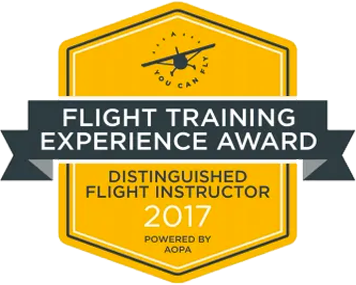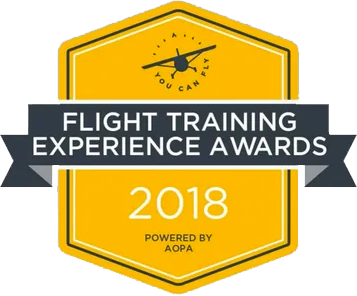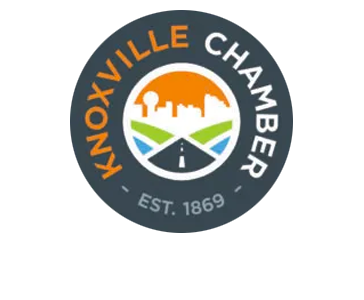Private Pilot Certificate
This is the beginning of your adventure in aviation!
Do you want to know why a lot more people don’t learn to fly? It’s not because they are afraid of flight. It’s because they see an airplane and think that it looks complicated. Then potential students are put off by all of the jargon and technical-sounding discussion they hear about regulations, angle of attack, cross-countries, weather, and a million other things that conspire to make learning to fly seem really difficult.
As a result, from the outside, learning to fly looks intimidating when it really shouldn’t. Of all the learning processes a person can experience, from riding horses to crocheting, none proceeds in the predictable orderly manner that flight training does. In many ways it comes down to a bunch of little squares that need to be filled in, and if you know what each of those squares requires ahead of time, any fear of the unknown should evaporate immediately.
The entire flight-training curriculum can be boiled down to an outline on a single sheet of paper. If this were done, you’d immediately see that training has several distinct “phases,” and each of those phases prepares you for the next one. This is all guided by a central plot that ties the story together and leads toward an exciting finale in which, after passing an oral examination and a flight test with a government-designated pilot examiner, you are handed a temporary pilot certificate.
Private Pilot requirements:(Before you Start)
- Be 16 years old to fly solo.
- Be 17 years old to receive your pilot certificate.
- Read, speak, and understand English.
- Hold at least a third-class medical certificate for private and recreational certificates. Sport pilots must hold at least a current and valid U.S. driver’s license.
Phases in obtaining your private pilot certificate:
Phase I: Pre-Solo phase
Enter the new student pilot.
OK, there you are. Green as grass and knowing nothing about flying. You’re standing at the ticket window trying to figure out how to get into the game. There are three or four basic paths you can take. None is wrong, some are more expensive than others, and some take longer than others. They are:
Accelerated flight school: You see their ads all over: “Come see us for a month and we’ll make you a pilot.” It depends on the school, but may be a good way to go and assumes you have the finances to invest in a short period of time . Check with the school to get pricing, and inquire on what you get for training ( amount of ground , and flight training)
Local flight school: Almost every airport has at least one flight school, and this is the most common way to go. Pick a school convenient to your home or workplace that’s been around for awhile and speak to some of its graduates to see what they think. This school should be able to take you by the hand and help you get your paperwork under way. Try to fly regularly – at least two or three times each week. By taking longer, you will forget what you have learned and have overlapping of training. This will cost more in the long run.
Freelance flight instructor: Using an independent instructor can be really good or really bad, depending on the instructor. This approach should give you more scheduling flexibility but works best if you own your own airplane. Pick your instructor carefully. Again, references from former students are like gold here – in addition to asking about the instructor’s teaching style and effectiveness, make sure he or she is punctual and not quick to miss an appointment.
The Phase I learning process requires a couple of overt actions on your part. Before you can solo (fly the plane by yourself )you’ll need to visit a Federal Aviation Administration-designated doctor for a straightforward flight physical; passing it earns you an airman medical certificate. You will also need a student pilots license and your flight school can help with this. You’ll also have to arrange for some sort of ground school; your instructor could give you the required ground instruction, but there are lots of other options.
Don’t sweat the medical exam. The FAA only requires that eyesight be correctable to 20/40 regardless of where it started. Blood pressure limits are 155/95, but you shouldn’t be walking around with BP that high anyway without having it treated. If you’re on medication, just let the aviation medical examiner know; multiple BP medications are approved by the FAA. In some situations feds may make you jump through a couple of hoops, but you’ll get the ticket in the end. There are only a handful of medical problems that will keep you out of the air. (To learn more about those conditions, see “Time Flies: You’re never too old to learn to fly,” December 2002 AOPA Flight Training.)
Ground school is intended to pass along the knowledge you need to be a safe aviator and pass the computerized knowledge exam, a prerequisite for the flight test. Participate in the training to acquire the knowledge and let passing the exam be the happy byproduct of a good education. That’s important. “Ground school” doesn’t even have to entail a class; the information has been prepackaged into a bunch of easily digested forms, including:
Local night classes – some colleges offer a private pilot ground school, as do many flight schools. Be sure to check your local community college and any continuing education programs.
Online programs – this is the newest way to go; they offer a lot of flexibility. You progress at your own pace and in your own home.
These work well but require more self-discipline; one drawback is that you can’t immediately ask questions as you learn. Fast Track Flight Training recommends this method because you can work at your own pace and save money, but we are there to help you if you run into difficulties with your studying.
The focus of the first act is to get you ready for solo. Yep, there’s the word, solo! It reverberates through aviation like the aviator’s rite of passage that it is. Because of that, it can looms before a student like a monster to be conquered, when it really is nothing more than a natural step in the training progression.
Here’s one absolute about your solo flight: It won’t happen until both you and your instructor know that you are ready. It won’t traumatize you. It won’t be difficult. It won’t be dangerous. It will, however, change your life. So, be prepared for that. It will be one of the most amazing days of your life.
Here again, the progression through the first phase is fairly predictable.
- Fly out into the practice area and learn how the airplane handles.
- Air work involves turns, climbs and descents, airspeed changes, stalls, and flying rectangular patterns.
- Pattern work showing you how all area work comes together in the landing pattern.
- Lots and lots of takeoffs and landings.
The length of Phase I varies considerably. For most students it happen faster than they can imagine.
Before your instructor kicks you out of the nest to fly yourself, you’ll have to pass a short written and flight test to make sure you picked up on some basics. Your instructor will keep you updated on your progress along the way. One lesson you will be informed you that you are getting close to soloing . Then one day your instructor will tell you that today may be the big day. You will be asked to do three landings with your instructor in the plane with you., if they are safe and you are feeling confident then your instructor will get out of the plane and let you fly solo in the traffic pattern. Even though you are in the plane by yourself you will still be able to talk with your instructor because he will be watching you and talking with you with a handheld raido. It’s as simple as that.
You’ll go home, and you’ll babble about it endlessly to anyone who will listen. Every little nuance of the landings will grow in importance in your mind, and you probably won’t sleep well that night as you replay your memory of flight over and over. Savor that feeling. Only a few personal events in your life will loom as large. End of Phase I.
Phase II: Building skills
All of the flying you’ve done to this point was aimed at preparing you to fly the pattern and make sure you can perform basic landings safely. Your instructor carefully selected the day on which you soloed, making certain the wind and all other parameters were such that you could easily handle them.
Then it’s time to start teaching you how to handle the “other kind” of days that may not be quite so simple. At the same time, you’ll start putting into action the navigation skills you learned in ground school. Further, the goal of Phase II is to prepare you to not only fly cross-country, but to make you safe when you arrive at your destination and find the winds and the runway to be much different than what you’ve been used to.
So, Phase II includes: crosswind landings (and lots of them); basic navigation and cross-country flights with your instructor; and specialty landings (short- and soft-field, but these might be put into a later phase).
Phase II is where you’ll learn the most in terms of really handling the airplane. It’s also where you’re going to be sent out alone to practice what you’ve been taught. You’ll learn some training exercises, like rectangular patterns, and you’ll learn more about things like stalls, which you’ll be expected to practice solo. Almost every flight will have you shooting at least a couple of landings. This is the fun part of training, especially if your progress and the weather are such that your instructor decides to work with short- and soft-field landings in this phase rather than teaching them later.
Another part of Phase ll with Fast Track Flight Training will be upset and basic aerobatic training. This is not a FAA requirement but highly recommended you will be a more confident and safer pilot. You will receive five lessons consisting of ground and flight training . Each lesson will be tailored to each student’s abilities and comfort level. Typically by the end of the complete course you will be doing the Falling leaf, Wing over, Rolls, Loops, Half and Full Cuban eights, Spins, Hammerhead stalls, and on the last lesson your instructor will invert the plane and you will be able to recover on your own. Talk about rewarding and confidence building how many people can say that they can do basic aerobatics and be able to recover from inverted flight. (Weight restrictions do apply)
Your cross-country work in Phase III will involve several solo cross-countries, so in Phase II your instructor will work with you to plan a couple cross-country flights.and he’ll fly them with you. You will do the planning and prepare your in-cockpit cross-country materials, including a flight log, and your instructor will check them over and make any corrections necessary. Then, you’ll get in the cockpit together and fly what you’ve planned out. If done correctly, you’ll see that flying cross-country is really nothing more than laying out a careful plan and executing it. Your instructor may not correct every minor error in your flight planning, however – allowing you to make mistakes that don’t compromise safety can be a very effective way to show what can result from poor planning.
Phase III: Solo cross-country
Flying your solo cross-country flights is really just like your first solo flight: Your instructor isn’t going to turn you loose if he thinks there’s even the slightest possibility that you’re going to have problems with skills, planning, weather, or anything else. An instructor wants his student to enjoy the solo cross-countries, not fear them. He wants his student to return having had a huge amount of fun as well as having learned a lot.
Ask any pilot – there is something magical about making your first solo landing at a far-away airport and walking into the FBO to get a drink. Your instructor may ask you to have your logbook signed by somebody at each cross-country stop, or ask you to phone your flight school after each landing – or not; schools’ procedures vary greatly.
You’ll have to make at least two solo cross-country flights – one to an airport that is at least 50 nautical miles from your starting point, and one that is at least 150 nm total distance with stops at two other airports.
Along the way your instructor will be following the FAA’s required checklist, making certain all the boxes are marked where it says you have to have completed specific tasks.
For instance, you’ll log a night cross-country flight with your instructor. You’ll also practice flight by reference to the aircraft’s instruments before you take the checkride. The goal here is not to teach you how to fly in instrument conditions; rather, this is emergency training designed to give you the skills necessary to safely maintain control and execute a timely 180-degree turn to get you back to VFR conditions should you ever inadvertently blunder into clouds or other low-visibility situations. End of Phase III.
Phase IV: Final scene
The final Phase has you honing every skill you’ve been taught to make them into a cohesive package that’s always available to make your flying safe and predictable. Think of it as a dress rehearsal for your checkride, which is fast approaching.
When you start taking lessons, your initial perception of the three-dimensional world is pretty basic: There is blue above and brown below, and you don’t see any details past that. Then, as you fly more and more, you start to catch up with the world around you, and everything seems to slow down for you. You find it easier to cross-check the airspeed and altitude while still keeping your eyes focused outside of the cockpit, looking for other aircraft. You notice that you actually do see the runway numbers “moving” on approach and giving you high/low indications, just as your instructor said you would. Where at first you were happy to be within 200 feet of an assigned altitude, you find it’s becoming easier to hold it to within 20. During this final phase, before taking the checkride, you’re going to take that increased level of awareness and put it to work for you.
It’s during this period that both you and your instructor will begin really enforcing performance parameters. Where in the past you didn’t get too concerned if you landed a little long, now you’ll be making certain that you land in the first little bit of the runway. More than that, you’re going to always pick out a spot and try to hit it every time. You were taught to do that from the beginning, but now you’re working at it.
Everything you do, from flying the pattern to working in the practice area, is going to be done with more specific goals in mind, more exact altitudes and headings. In the hours leading up to this period your mind was clouded with new information and new skills to be learned. Now, however, your goal is to polish the skills you’ve learned and make your flying more exact and intuitive. You are converting yourself from an approximate pilot to a specific one. You’ll have a well-defined path in your mind and you’re going to fly it as exactly as you can.
Then comes the day for the checkride.
First, keep this in mind: Every student recommended by their instructor will be nervous before the checkride, but if your instructor didn’t think you were ready, he wouldn’t put his reputation on the line and recommend you for the test. You have already proven yourself to your instructor.
The character of the checkride can vary considerably and is driven by the FAA’s Private Pilot Airman Certification Standards – a document that specifies what you must accomplish and establishes the standards to which you must perform – as well as the approach your examiner takes to the evaluation. A very few of them are the legendary gruff, by-the-book, do-it-my-way types who are determined to show you who is boss, but you almost never run into this type any more. Most examiners – the better ones anyway – aren’t so much check pilots as they are check instructors. They are the last instructor you’ll fly with before you’re on your own (and able to legally carry passengers), and they need to know that you have learned enough to be safe. The good ones will even show you how to get better.
Regardless of what kind of a pilot examiner you get, the only thing you can do is try to relax and fly your best.

So, what’s the next move?
That’s up to you.
Why don’t we make a deal: After reading this, if you haven’t already done so, call Fast Track Flight Training – and say that you want to take an introductory flight lesson. Don’t get any more complicated than that. Just ask for an introduction. If you make that first step, everything else will take care of itself.



